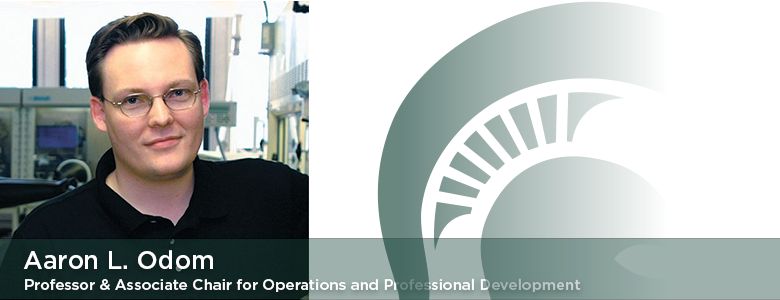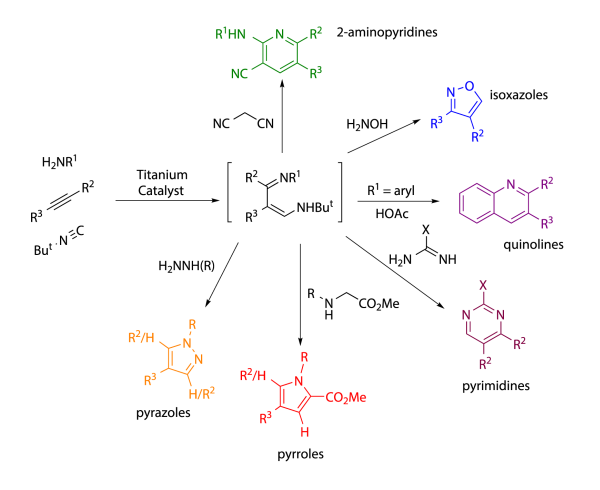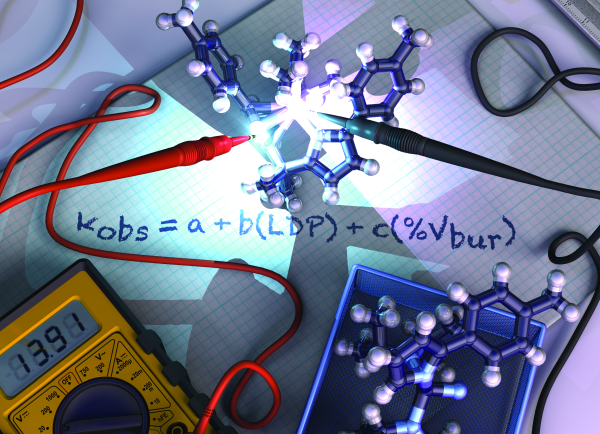Aaron L. Odom

Research
Organometallic/Inorganic Synthesis and Transition Metal Catalysis in Organic Synthesis
(Research Description PDF)
Finding sustainable and environmentally friendly approaches to products is one of the major challenges facing chemists. Some important developing methodologies for producing target compounds in fewer steps with less waste are catalyzed multicomponent coupling reactions, which allow access to structurally complex compounds in a single step.
In one project, our group is developing titanium-catalyzed multicomponent coupling procedures to make nitrogen-based heterocycles either in a single pot or in a single step. Titanium catalysis is advantageous in that the metal is both abundant and nontoxic.
In the exploding diagram are some of the procedures developed for heterocyclic synthesis. These new protocols are applied to natural product synthesis and investigated for their biological activity. For example, with the Tepe group, we have discovered a new class proteasome inhibitor based on the quinoline core structure with potential applications in inflammatory disease and cancers like multiple myeloma.
 To evaluate ligands for early transition metal catalysis, like in the project above,
we have developed a chromium(VI), d0-system that is very synthetically versatile, NCr(NPri 2)2X, where X is the ligand under scrutiny. Using this system, we parameterize ligands
based on their sterics and electronics. In one application, we were able to model
the reactivity of a series of titanium hydroamination catalysts and determine quantitatively
how the sterics and electronics of the ancillary ligand contributes to reaction rate.
Once the model was established, we could anticipate what the reaction rate would be
in many cases. This methodology is now being applied to a variety of different catalytic
reactions.
To evaluate ligands for early transition metal catalysis, like in the project above,
we have developed a chromium(VI), d0-system that is very synthetically versatile, NCr(NPri 2)2X, where X is the ligand under scrutiny. Using this system, we parameterize ligands
based on their sterics and electronics. In one application, we were able to model
the reactivity of a series of titanium hydroamination catalysts and determine quantitatively
how the sterics and electronics of the ancillary ligand contributes to reaction rate.
Once the model was established, we could anticipate what the reaction rate would be
in many cases. This methodology is now being applied to a variety of different catalytic
reactions.
In these projects, and others, we are attempting to widen and optimize the applications of transition metals, and we are investigating new possibilities for applications in human health and other areas.

Contact / Webpage
Area(s) of Interest
Inorganic (In)
Organic (Or)
Organometallic (Om)
Selected Publications
Quantifying Ligand Effects in High- Oxidation-State Metal Catalysis, Billow, B. S.; McDaniel, T. J.; Odom, A. L., Nature Chem. 2017, 9, 837-842.
Titanium-Catalyzed Multicomponent Couplings: Efficient One-Pot Syntheses of Nitrogen Heterocycles, Odom, A. L.; McDaniel, T., J. Acc. Chem. Res. 2015, 48, 2822-33.
A Single Complex with Chromium-Nitrogen Single, Double, and Triple Bonds: Synthesis, Structure and Reactivity, Beaumier, E. P.; Billow, B. S.; Singh, A. K.; Biros, S. M.; Odom, A. L., Chem. Sci. 2016, 7, 2532-2536.
A 4-Coordinate Ru(II) Imido: Unusual Geometry, Synthesis, and Reactivity, Singh, A. K.; Levine, B. G.; Staples, R. J.; Odom, A. L., Chem. Commun. 2013, 49, 10799-801.
Titanium-Catalyzed, One-Pot Synthesis of 2-Amino-3-Cyanopyridines, Dissanayake, A. A.; Odom, A. L., Adv. Synth. Cat. 2014, 356, 1811-1822.
Substituted Quinolines as Noncovalent Proteasome Inhibitors, McDaniel, T. J.; Lansdell, T. A.; Dissanayake, A. A.; Azevedo, L.; Claes, J.; Odom, A. L.; Tepe, J. J., Bioorganic and Medicinal Chemistry 2016, 24, 2441-2450.
CV
B.S., 1993, Texas Tech Univ.
Ph.D., 1997, Massachusetts Institute of Technology
Postdoctoral Research Fellow, 1998-1999, Massachusetts Institute of Technology
Awards
| Year | Award | Organization |
|---|---|---|
| 2017 | Favorite Molecule of the Year | C&E News Readers |
| 2004 - 2006 | Alfred P. Sloan Fellowship | Alfred P. Sloan Foundation |
| 2001 - 2002 | Member | American Chemical Society (Michigan State University Local Section) |
| 2001 - 2004 | Young Investigator Award | Office of Naval Research |
| 2000 | Presidential Early Career Award for Scientists and Engineers (PECASE) | |
| 1999 | Early Career Scientist and Engineer Award | Department of Energy (Defense Programs) |
| 1997 | Ph.D. | Massachusetts Institute of Technology |
| 1995 - 1996 | Texaco Fellow | Massachusetts Institute of Technology |
| 1993 | Bachelor of Science | Texas Tech University |
| 1991 - 1993 | Hoercht-Celanese Academic Scholarship |